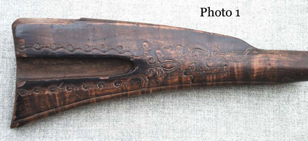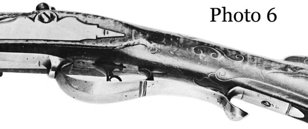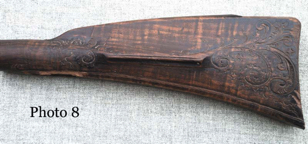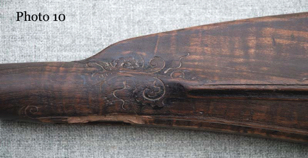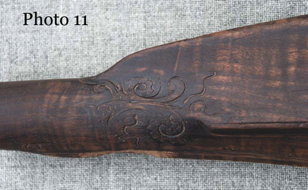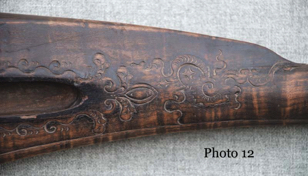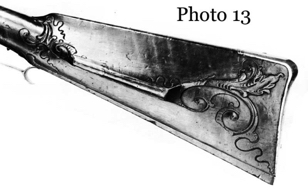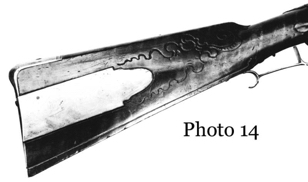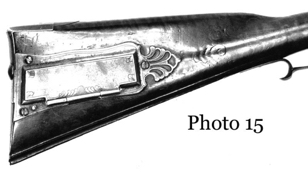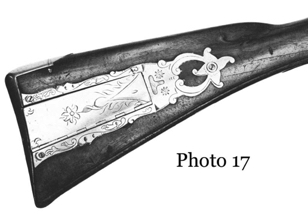An Unknown Master near Allentown
This remnant (photos 1, 2) is all that remains of a severely damaged rifle of the 1785-1800 period that is believed to have been constructed in Northampton County, Pennsylvania. More specifically, it probably was made by a gunstocker - and a highly competent one at that - working somewhere in the vicinity of Allentown. Unfortunately, the rifle was badly broken through the lock and wrist and the other remains have vanished. The stock is extremely similar in profile to signed work of John Moll and maintains the same robust [considering the style and period] 'squashed' proportions: the buttstock is nearly 1 7/8" wide and would have been approximately 4 3/4" in height. The now-missing buttplate is somewhat atypical of the common Lehigh Valley-area 'sheath' buttplates, the upper extensions of which were inlet into the top of the comb without actually spanning it full-width; the inletting upon this piece displays a complete span and furthermore a thumbnail-shaped extension at the fore (photo 3). [Similar decorative extensions have been noted upon work attributed to Isaac Berlin of Easton (photo 15), John Moll Jr. of Allentown (photo 16) and William Antes (photo 17) including occasional usage amongst various Bucks County gunmakers, establishing a strong but varied regional usage.] This 'thumbnail' is repeated upon the rear tab of the remaining triggerguard inletting. The width of the toe flat is approximately 3/4" and only tapers slightly toward the front, and the guard inletting is somewhat wide and nearly spans it completely (photo 4). This emphasis upon width in relation to height or length is likewise repeated in the wrist, the residual portion somewhat forward of the comb and lower step measuring a full 1 7/16" wide but only 1 3/16" tall. The stock further displays a very interesting form of cast-off that was occasionally utilized upon pieces traceable to the Lehigh Valley area, eastern Berks County and thence later extending northward into the upper Susquehanna River region of Northumberland, Union and Mifflin Counties; this form of cast revolves around a graceful, continuous curve rather than a straight axis. Viewed from above or below, the comb and toe profile lines are possessive of noticeable arcing curvature away from the shooter's face (photo 4). These curves appear to have been incorporated deliberately.
Even more interesting than comparisons with other typical rifles of the region are the notable dissimilarities present. The fine double-line toe molding is quite typical, however more often than not these moldings simply 'run-out' in the area of the lower step with no concise termination. I have seen very little in the way of comparative Allentown-area work wherein this molding carries completely around under the guard grip-rail and forming a continuous loop, save upon Shumway's RCA 60 (photo 16) which was made by either John Moll II or possibly John III. The molding upon this rifle surrounds the rear guard tab inletting to form a simplified fleurdelis (photo 4) which appears to be quite similar to what is found upon signed Bucks County work of Andrew Verner (photo 5), John Shuler (photo 6, w/ similar 'thumbnail') and others. Also notable is the fact that, unlike the majority of signed Lehigh and Bucks work of the same period carrying a comparable level of carved decoration, this rifle displays no associated inlay work: no toeplate, cheek inlay or wrist inlay is present. Relative to such a well-carved rifle, this might perhaps represent a conservative bent.
Immediately evident is the fact that the box mortise is relatively deep and was cleared away completely to the inside surface of the now-missing buttplate (photo 7). This was primary work as there is no evidence of wood having been either broken out or otherwise removed at a time subsequent to construction. The cavity measures 4 1/2" in length and is somewhat rounded at the fore, displaying a number of angular and clean gouge cuts. Furthermore, the floor of the mortise was leveled with a very shallow gouge rather than a flat chisel. It is 3/4" in depth at the rear (along the butt) and tapers upwards to 5/8" depth at the front. The dovetail cuts for the lid are fairly shallow and do not extend all the way to the forward portion of the mortise. It would appear that the box lid was gently tapered along the sides and came to a blunted or radiused point at the nose. In addition to the rarity of this type of box mortise, a second noteworthy feature [which would not have been visible had the buttplate been in place] is a curious and inexplicable hole which was bored into the stock above the box mortise, between it and the comb. This hole, as far as I can tell, is very old and seems to be primary work; it parallels the box mortise in orientation, is likewise 4 1/2" long and approximately 1/2" diameter. There is no evidence of anything being stored within and the purpose for such a hole, which is not completely unknown upon other arms but is of extreme rarity, is unknown.
The cheekpiece is rather long (photo 8) for this particular style of stock architecture, although it is well-shaped and molded and does not appear awkward. It measures 3 13/16" in length along the top and, in orientation, seems to approximately parallel the comb. Flanking either side of the cheek, extending around the comb and proceeding to fill much of the box-side of the buttstock is some of the most elaborate relief carving I have ever viewed upon a Lehigh-area rifle (photos 9, 10, 11). This carving is quite complex and there can be no doubt that it was almost entirely executed via 'stamping' with a set of various gouges. It is always difficult to interpret 'tool technology' when viewing a two centruy old rifle, especially in consideration of the inevitable wear present, but under magification it does appear that little (if any) of this carving made use of a 'V' parting tool; this goes somewhat against the grain in comparison to the majority of Federal-era Lehigh pieces. As best I can determine, the carving was relieved with almost no scraping whatsoever but rather very accomplished grounding with a small flat or skew chisel. It would appear also that the stamped pattern outlining was back-cut with the same gouges as well as judicious use of a knife blade. The design to the rear of the cheek (photo 9) evidences strong similarities to the 'common' Allentown form best represented by the rifles of John Moll and Herman Rupp, however it is more complex than the extant examples of either man and is different enough in form and execution to effectively rule out either man as the maker. Also present within this portion of the carving, as well as once upon the box-side, are curious sets of four gouge cuts which almost can be viewed as forming small cross-like forms. These are not known upon any other regional rifles of which I am aware.
Forward of the cheek (photo 11) is a complex form which seems to display some similarity to the carving present upon William Antes' swivel-breech rifle as well as RCA 42. This is very different from the forms typically utilized by Moll, Rupp or Neihart and displays the "rebounding scrolls," as Wallace Gusler has pointed out within his series of articles concerning "Rifle Gun no. 42," which are found upon RCA 42 as well as the 'Musician Rifle' likewise illustrated within Gusler's articles. Upon the piece displayed here, the root form of the design is not oriented vertically - there would not have been room to do so - but rather is turned ninety degrees along a horizontal axis. This carving leads into a fleurdelis which frames the comb and then proceeds around to the box-side. There is a very elaborate bit of stand-alone box framing (photo 7) which is most interesting in that the scrollwork along the sides would at first glance seem to mimic signed work of Moll, Herman Rupp and potentially John Rupp, however upon closer examination can be seen to be reversed in the orientation of the scrolls. This scrollwork moves into a closed finial (photo 12) which in many ways can be viewed as a carved version comparable in form to the forward finial utilized upon regional brass boxes. The portion of the carving which runs off the comb flows back towards this box framing in a very accomplished manner which both creates a 'cameo' wrist at the same time. It does not actually tie into the carving which surrounds the box. The carving here would seem to display closer parallels in form to German work as opposed to American work, although the similarity to the carving present upon RCA 42 is rather self-evident.
I would once more draw close attention to the decorative work upon this rifle and note the uncanny connections between it and the decorative carving present upon RCA 42 (photos 13, 14). Much of the fine detail and methodology is the same, although unfortunately - as with comparisons between 42 and the Marshall Rifle [RCA 41] - this rifle has suffered a high degree of wear which RCA 42 has not. Many portions of the fine detail have been lost, their existence only defined by vague traces of the preliminary stamping. It is impossible to determine how 'raised' the carving originally may have been, although it can be said for certain that the work was boldly and confidently cut. While it is probable that approximately ten to twenty years separate this rifle from RCA 42 in regards to period of construction, it is very difficult to view the two pieces and not come to the tentative conclusion that they were constructed by the same man, or at the very least by two individuals who were intimately associated. At the purely visceral level, the carving obviously looks as though it were carved by an identical hand. Certainly many other attributions have been based upon far less supportive evidence. If a moment is taken to view RCA 42 within the traditional context of Northampton County and the assumed progression of rifle evolution in the region [i.e. a heavily German-influenced step-stock architecture (RCA 42) evident in the early pre-War period, through a War-era transition as characterized by Oerter's work to that of a post-War stepped-curvature epitomized by Herman Rupp and John Moll], it would then make perfect sense to view this piece as bearing witness to the work of a highly-trained gunstocker who was a resident of the region ca. 1765 through 1790 and who was swept up in the changeable winds of firearm design. It is assumed that known regional smiths such as Peter Neihart or John Moll were an integral part of this change, both men being of appropriate age and proven to have been working in the 1760s (earlier in Moll's case) as well as after the War and into the early Federal Period. Concerning these two men, there is ample documentation supporting location and also extant signed, post-War rifles. However, no signed pre-War pieces are known so it is impossible to accurately surmise what these men may or may not have stocked during the early period, and thus impossible to establish a proven Allentown-area benchmark. Conversely, in comparing RCA 42 with this particular Federal-era rifle, it is possible to view two pieces which could be interpreted as representing pre-War and post-War production by one individual or perhaps two individuals of master/apprentice relation, but unfortunately there is no way to determine either a name(s) or exactly where he/they may have worked; all that is certain when viewing this particular remnant is the obvious recognition of a strong Allentown-area flavor.
